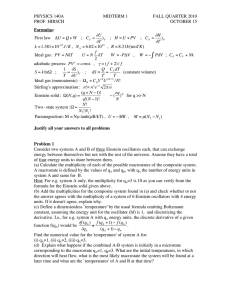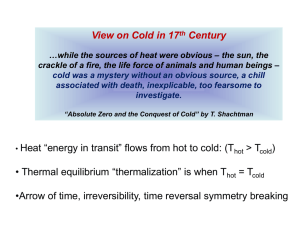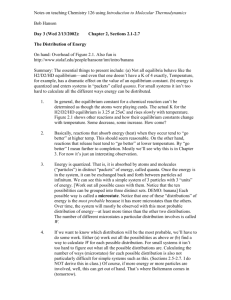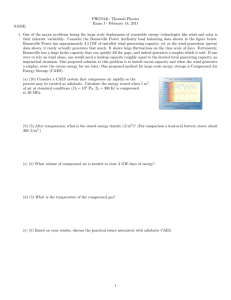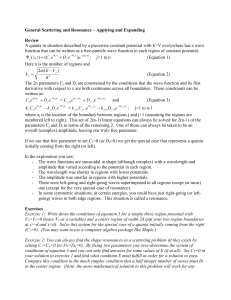Guided Inquiry Worksheet 1: Microstates, Macrostates, Macropartitions & Probabilities
advertisement
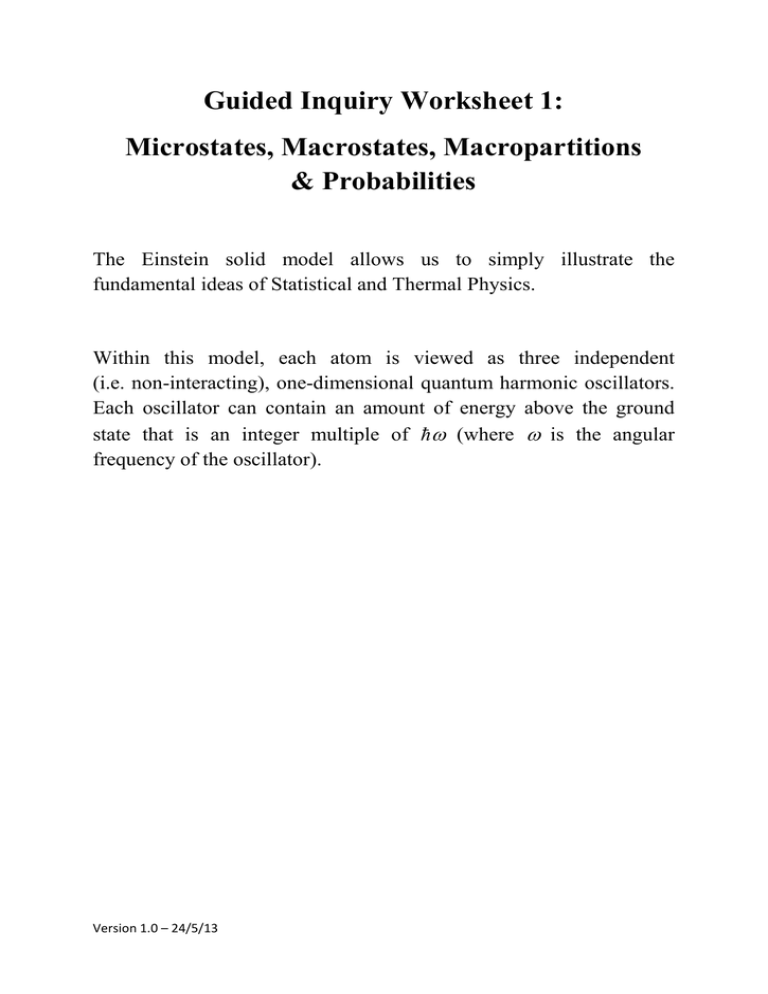
Guided Inquiry Worksheet 1: Microstates, Macrostates, Macropartitions & Probabilities The Einstein solid model allows us to simply illustrate the fundamental ideas of Statistical and Thermal Physics. Within this model, each atom is viewed as three independent (i.e. non-interacting), one-dimensional quantum harmonic oscillators. Each oscillator can contain an amount of energy above the ground state that is an integer multiple of ħ (where is the angular frequency of the oscillator). Version 1.0 – 24/5/13 Activity 1: Single Isolated Einstein Solid Consider an isolated Einstein solid comprising a single atom with three quanta of energy While we know that this solid always contains three quanta of energy (it is isolated), the exact arrangement of the quanta within the solid is not specified. We can represent the possible arrangements of quanta within the solid in numerous ways. One option is to indicate the energy level occupied by each quantum oscillator: Alternatively, a set of three numbers could be used to specify how many quanta each oscillator contains: ≡ 210 Finally, using dots to represent single quanta and a “|” to indicate a partition between oscillators, we could represent the arrangement as: ≡ Version 1.0 – 24/5/13 210 ≡ ●●|●| Each possible arrangement of quanta within this system is known as an accessible MICROSTATE (inaccessible microstates are those that do not respect the overall constraints on the system- e.g. they have too much or too little energy, or the wrong number of oscillators etc.). For an Einstein solid, specifying the microstate amounts to giving the number of quanta in each oscillator. In general, knowing the microstate of a system means that you know all of the system’s details! 1.1) Using your preferred notation, represent all of the possible (i.e. accessible) microstates of our single atom Einstein solid with three quanta of energy: What each of these microstates has in common is the total energy and total number of oscillators. We say that all of these microstates belong to the MACROSTATE corresponding to three quanta of energy in the three oscillator system. The accessible microstates of an isolated system are all members of the system macrostate described by the conserved quantities energy, particle number etc. Version 1.0 – 24/5/13 Specifying the macrostate of a system, amounts to describing the system in more general terms than when describing a microstate. 1.2) For our single atom Einstein solid with three quanta of energy, specify at least three different macrostates. The number of microstates corresponding to a macrostate is called the MULTIPLICITY OF THE MACROSTATE 1.3) What is the multiplicity of the macrostate corresponding to three quanta of energy in our single atom Einstein solid? 1.4) What is the multiplicity of each macrostate specified in 1.2)? Version 1.0 – 24/5/13 THE FUNDAMENTAL ASSUMPTION OF STATISTICAL MECHANICS: all allowed microstates of an isolated system are equally likely, once the system reaches equilibrium 1.5) Why, do you think, does the fundamental assumption require the system to be in equilibrium? 1.6) At equilibrium, which microstate of our single atom Einstein solid is most likely? Explain. Version 1.0 – 24/5/13 1.7) At equilibrium, for our single atom Einstein solid, what is the probability that … a) … each oscillator contains a single unit of energy? b) … the first oscillator has one unit of energy? c) … the second oscillator has two units of energy? 1.8) Can you propose a general formula for the probability P(s) of the system being in a certain state s at equilibrium, in terms of the multiplicity of this state (s) and the total number of accessible microstates all? Version 1.0 – 24/5/13 Before you proceed, explain in your own words what is meant by the following terms (give as general a description as possible− i.e. not restricted to an Einstein solid): MICROSTATE: MACROSTATE: MULTIPLICITY: FUNDAMENTAL ASSUMPTION OF STATISTICAL MECHANICS: Version 1.0 – 24/5/13 Activity 2: Two Small Interacting Einstein Solids Consider two interacting Einstein solids A and B, each with three oscillators. The combined system of A and B is isolated with a total of three quanta of energy 2.1) What do all arrangements of this combined system have in common? In other words, how would you describe the most general macrostate of the combined system? The other extreme to specifying the most general macrostate of the combined system, is to specify exactly how many quanta each oscillator contains. This amounts to specifying the microstate of the system (i.e. all of the details!). 2.2) Can you think of another way of describing arrangements of quanta within the composite system that is less specific than the microstate, but more detailed than the most general macrostate? Version 1.0 – 24/5/13 One option is to specify how many quanta of energy one of the solids contains (e.g. the number of quanta qA in solid A). Of course, once this is specified, the number of quanta in solid B is also known, since the total number of quanta is given. This choice amounts to specifying the MACROPARTITION (or energy split) of the system (clearly, a macropartition is just a special kind of macrostate). 2.3) How many macropartitions does the combined system of A and B (sharing three quanta) have? Now, for each macropartition, count how many ways the energy can be arranged within A and B (i.e. the multiplicities of A and B for the given energy split, A(qA) and B(qA) respectively, as well as the total multiplicity of the combined arrangement total(qA)): 2.4) Complete the table: qA qB ΩA(qA) ΩB(qA) Ωtotal(qA) P(qA) (%) (leave the final column for now− we will return to it slightly later) Version 1.0 – 24/5/13 2.5) On the same set of axes, draw sketch graphs of A, B and total (the number of possibilities open to A, B and the combined system for each of its macropartitions). Clearly label each graph and axis. 2.6) What is the total number of microstates all available to the combined isolated system? Version 1.0 – 24/5/13 2.7) Using the fundamental assumption of statistical mechanics, determine the probability of each macropartition and complete the final column of your earlier table. (recall the general formula proposed in 1.8) Under what conditions do these probabilities apply? 2.8) At equilibrium, are all macropartitions of the combined isolated system equally likely? Explain. Version 1.0 – 24/5/13 Activity 3: Two Interacting Einstein Solids of Different Sizes Consider two interacting Einstein solids A, with 3 oscillators, and B, with 6 oscillators, sharing a total of 6 quanta of energy The task of manually counting microstates is tedious (even for systems as small as those in this activity). This task will be left to a computer slightly later. For now, let us focus just on the qualitative behaviour. 3.1) How many macropartitions are available to this system? 3.2) On the same set of axes, draw sketch graphs of A, B and total. You do not need to explicitly calculate the multiplicities, but think carefully about the general features of each graph (e.g. increasing or decreasing, concave up or down, relative positions of minima or maxima and endpoints). Version 1.0 – 24/5/13 3.3) Can you predict what the most probable macropartition will be for this system? What was the basis for this prediction? If a prediction is not possible, can you think of a situation in which it would be possible? 3.4) Can you predict the average energy content of A at equilibrium? What was the basis for this prediction? Version 1.0 – 24/5/13 For each case below, decide which of the following is or are known: the microstate, macrostate, and/or macropartition (the systems are not necessarily at equilibrium): i) two ideal gases A and B share a total of 1 000 J of energy and are isolated from the surroundings ii) two Einstein solids 1 and 2 share 100 energy units with 80 units in solid 1 iii) the number of quanta in each oscillator of a two Einstein solid system is known iv) the positions and momenta of all particles in an isolated ideal gas are known Version 1.0 – 24/5/13 Activity 4: Java Applet: Comparison with Earlier Results Explore the EJS applet, No1_ EinsteinSolidMultProb.jar. It allows one to specify the number of oscillators in two interacting Einstein solids A and B, as well as the total energy available to the combined isolated system. The process of manually counting the number of possibilities open to a system in a given macrostate (i.e. its multiplicity) is tedious. Fortunately, this applet calculates the multiplicities using the combinatorics approach discussed in lectures. 4.1) Check that your answers to Activity 2 agree with the applet and record any discrepancies below. When comparing graphs, make sure that all features agree (e.g. overall trend, concavity, domains and ranges, endpoints and positions of peaks): 2.3: 2.4: 2.5: 2.6: 2.7 & 2.8: Version 1.0 – 24/5/13 4.2) Now, use the applet to investigate the system considered in Activity 3. Do your sketch graphs match the applet’s output? If not, how are they different? Can you explain the discrepancies? 4.3) Was your prediction for the most probable macropartition confirmed by the applet? If not, why? 4.4) Use the applet to calculate the average energy content of A at equilibrium. Does this confirm your earlier prediction? Can you generalise the result obtained for the average energy content of A at equilibrium to solids with NA and NB oscillators respectively, sharing qtotal quanta? Confirm your result using the applet. FOR THE MOMENT, EXIT THE APPLET Version 1.0 – 24/5/13 Let us now investigate the effect of system size on multiplicities and probabilities by considering the following cases: Case 1: NA = 3 and NB = 3 with 3 quanta of energy Case 2: NA = 30 and NB = 30 with 30 quanta of energy Case 3: NA = 300 and NB = 300 with 300 quanta of energy Sketch the macropartition probability distribution for each case. You do not need to perform any calculations, but think carefully about the general features of each graph as you did in 3.2. 4.5) Case 1 P(qA) qA Case 2 P(qA) qA Case 3 P(qA) qA Version 1.0 – 24/5/13 Reopen the applet and check your predictions (tick “Display Probability Plot”). 4.6) How does the probability distribution change as the system is scaled up in size? Pay particular attention to the height, peak position and width of the distribution. Height Peak Position Width Case 1: Case 2: Case 3: 4.7) Limited computational power prevents an analysis of systems with Avogradro’s number of oscillators and energy units, but what would you expect probability distributions for such systems to look like, based on your observations here? Version 1.0 – 24/5/13
